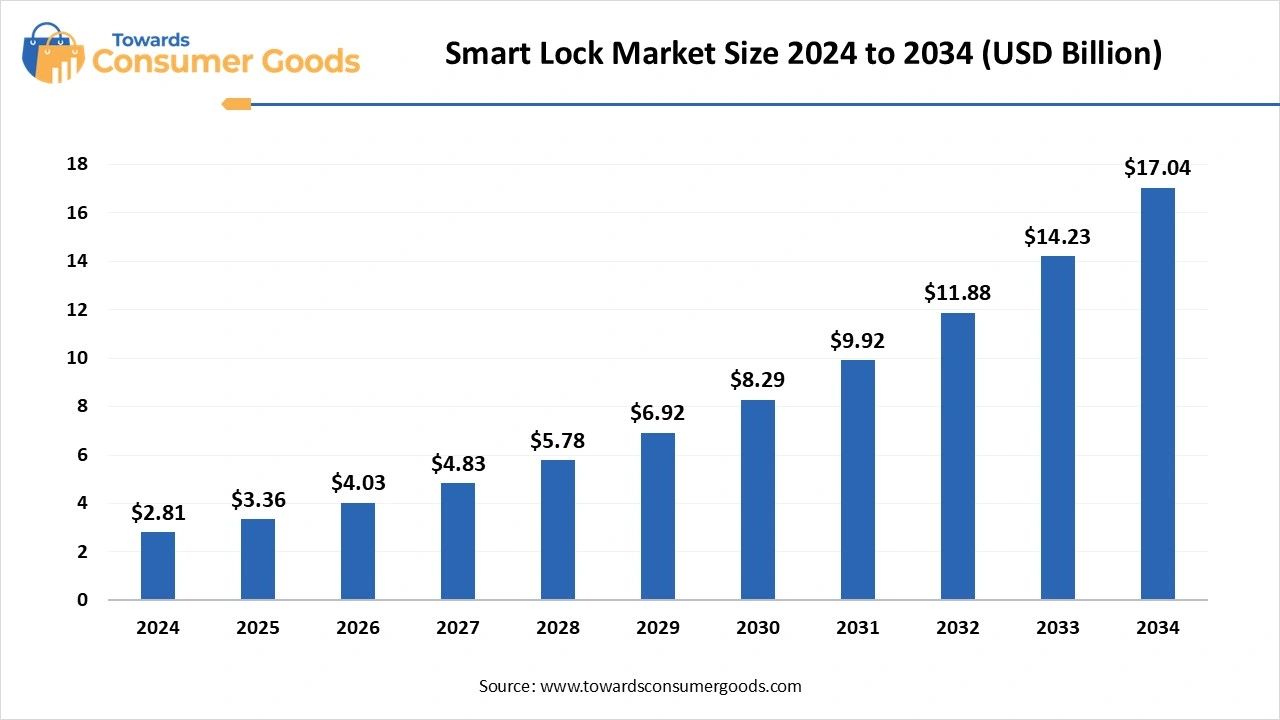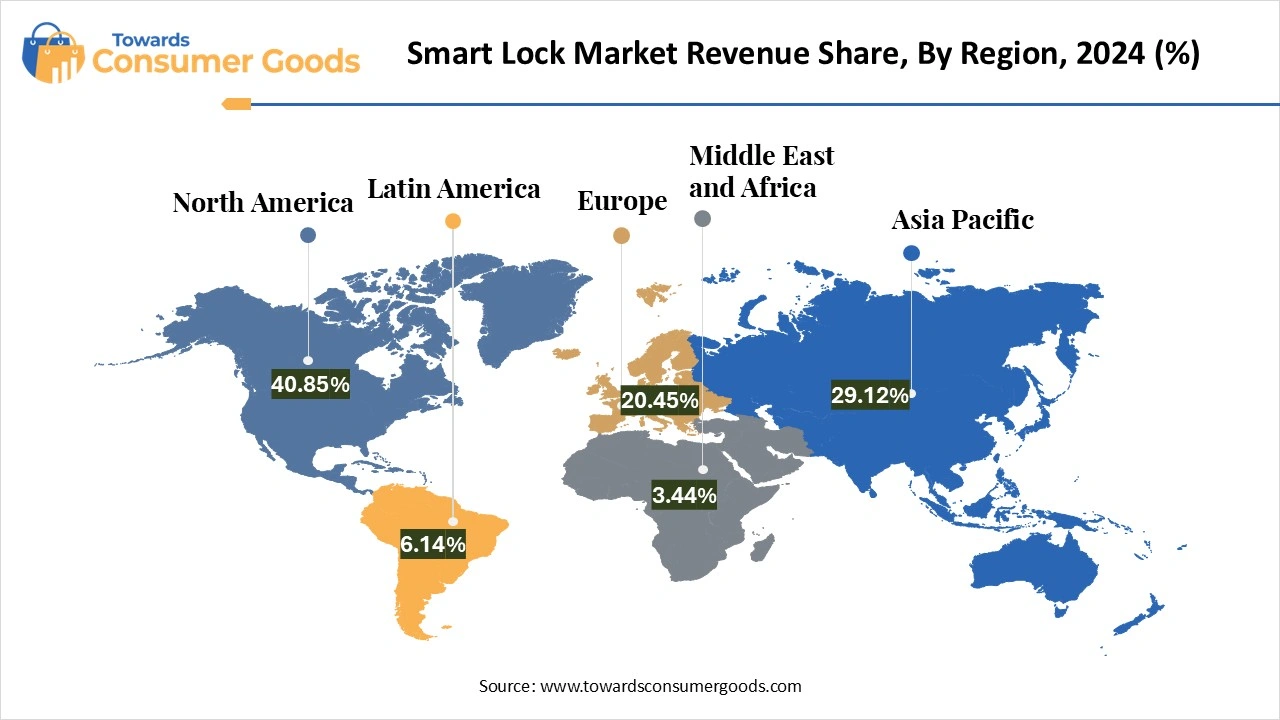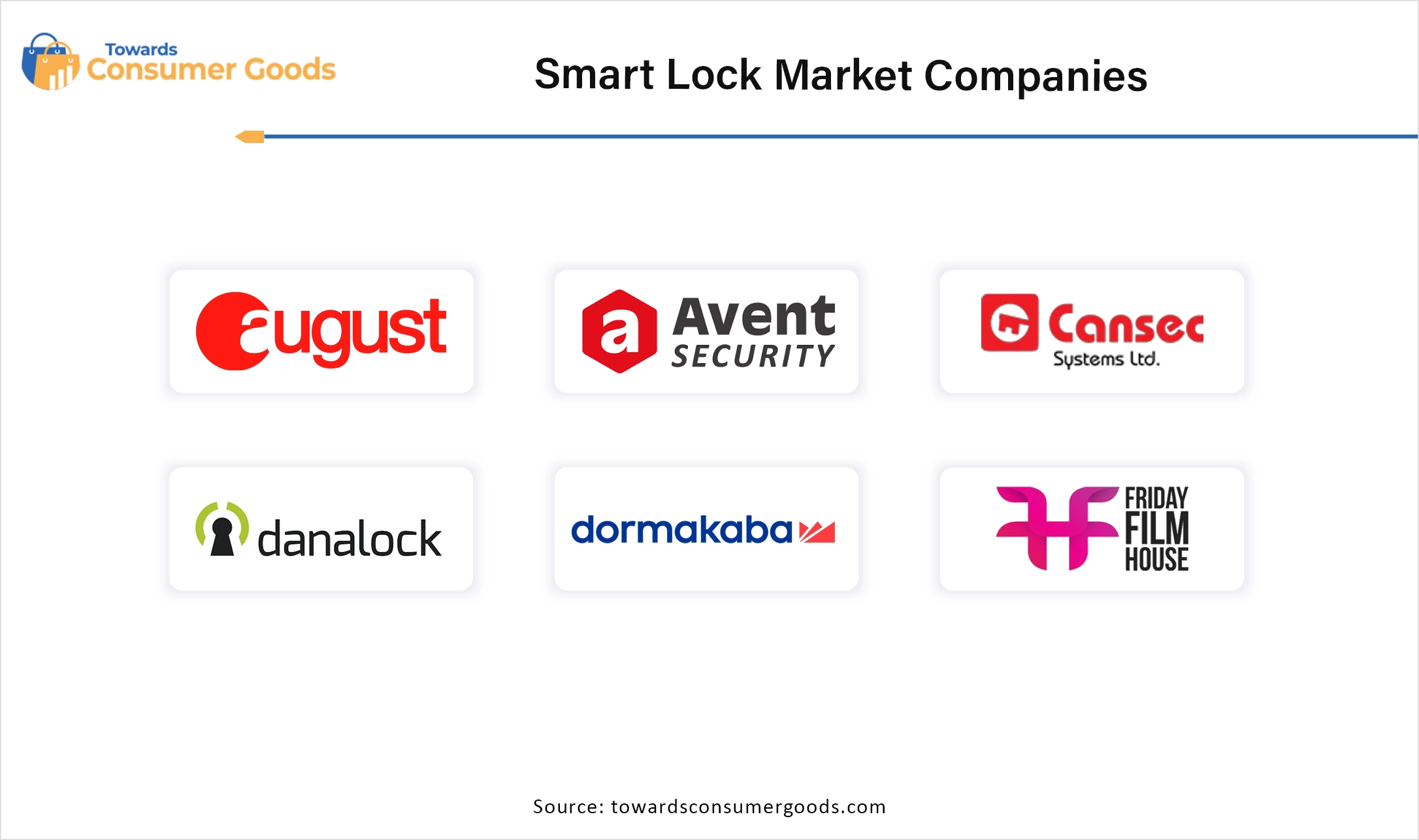April 2025
The smart locks market is estimated to increase from USD 3.36 billion in 2025 to USD 17.04 billion by 2034, The market is projected to record a CAGR of 19.75% during the forecast period from 2025 to 2034. This growth is driven by the rising demand for enhanced home security solutions.

The global smart locks market has expanded dramatically in recent years as more customers choose state-of-the-art security systems. By controlling access using smart technology like RFID cards, fingerprint scanners, keypads, or smartphone apps, these locks are safer and more practical than traditional locks. Increasing urbanisation, rising incomes, and growing worries about home and workplace security are some of the causes driving up demand for digital locks across the country. The popularity of advanced locking systems is growing as homes and workplaces become more intelligent.
As more people looked for touchless, sanitary home security solutions, the COVID-19 pandemic increased this trend. Smart locks have become popular due to their hands-free entry and easy-to-use capabilities. Future market integration is expected to provide more advanced biometric systems and IoT-enabled capabilities that will not only improve security but also give businesses and homeowners better control and user-friendliness.
| Report Attributes | Details |
| Market Size in 2025 | USD 3.36 Billion |
| Expected Size in 2034 | USD 17.04 Billion |
| Growth Rate | CAGR of 19.75% |
| Base Year in Estimation | 2024 |
| Forecast Period | 2025-2034 |
| Dominant Region | North America |
| Segment Covered | By Product, By Application, By Protocol, By Authentication Method, By Region |
| Key Companies Profiled | Adel, ASSA ABLOY, Schlage, Lockly, August Home, Securitech, MiLocks, Allegion, ZKTeco, Samsung, Kwikset, Samsonite, Danalock, Honeywell, Yale |
Integration of product with expanded end-users
The smart locks market or smart locks is growing quickly due to advanced technology and changing consumer needs. One major benefit is the rise of linked home systems, of which smart locks are increasingly becoming integral components. These locks offer more convenience and security, especially when combined with other smart devices like cameras or alarms.
Brands are focusing on features that are easy to use and smooth mobile applications to improve the user experience. Furthermore, increasing funds are being allocated to technologies that facilitate early security issue detection and timely response, such as artificial intelligence and machine learning.
Residential use is expected to rise rapidly as more people switch to smart homes. This development is making new service models more available, such as monthly plans for real-time warnings and remote monitoring. Because of their ability to interface with other smart devices, these locks are becoming more and more essential for tech-savvy homes looking to create a secure and connected living space.
High Cost
Digital door locks are becoming more and more popular as people prioritise safety and privacy. Customers can now choose from a wide range of smart locks based on their needs. However, there are a few factors that hinder the industry’s growth.
The high cost of these locks, especially in poorer countries like South America and parts of Asia-Pacific, is a major barrier. Price is influenced by features, and biometric locks for offices are usually more expensive than keypad locks. The total expansion of the global market for digital locks is slowed by high production costs, which also affect affordability and adoption.
North America dominated the smart locks market by generating the highest revenue share in 2024. The rising popularity of smart home tech and growing concerns about safety are pushing demand for high-tech locking systems in the region is the main cause of the widespread industry. The spread of IoT gadgets, better wireless tech like Bluetooth and Wi-Fi, and smooth integration with home automation systems are all helping boost market growth.
In North America, the U.S. leads the way with a strong customer base and a clear interest in smart home setups. The presence of top brands and a steady stream of new, innovative products are key drivers behind the expanding smart lock market in the region.

Asia Pacific is anticipated to grow at the highest CAGR during the forecast period of 2025 to 2034. Rapid urbanization, growing affluence, and an increase in construction projects in nations like China, India, and others in Southeast Asia are driving the demand for smart security systems.
Residents in this area are becoming quite interested in keyless entry systems and smart home designs. Digital door locks are growing in popularity due to their ease of use, convenience, and enhanced safety, which is supporting the market's continuous rise throughout Asia Pacific.
Europe is expected to grow at a notable rate in the upcoming years. The industry's main drivers include the region's increasing interest in smart home technologies and strict security requirements. Both traditional and smart lock systems are in strong demand in Europe, and regulations are fostering future industry expansion.
Meanwhile, regions like Latin America and the Middle East, and Africa (MEA) are showing a lot of promise. In Latin America, rising urbanization and technological use create new opportunities, yet social inequality and economic issues may limit growth. The expanding middle class and safety concerns in the MEA are driving up interest in smart locks, but barriers could come from disjointed markets and loose regulations. Both areas have good growth prospects despite challenges because of improved tech environments and growing demand for smart home items.
The deadbolt segment dominated the market with the largest revenue in 2024. This smart lock smoothly interacts with Adobe's smart home system, making it simple for users to improve their home security setup. The best part is that it's a simple and quick way to improve home security without replacing the antiquated deadbolt.
The level handler segment is expected to grow at the highest CAGR during the forecast period of 2025 to 2034. These locks are becoming more and more popular in offices, hospitals, and multi-family buildings because of their simplicity of use and adherence to ADA guidelines. Because of their innovative design and adherence to access protocols, they are perfect for areas with a lot of foot activity every day.
In terms of application, the residential sector generated the highest revenue in 2024. As more people switch to smart homes, smart locks are growing in popularity due to their convenience and security features. An increasing number of homeowners are opting for remote-controlled locking systems as part of their linked home configurations.
Additionally, projected that the commercial segment will grow at the fastest rate from 2025 to 2030. Businesses are using digital locks to automate access control, monitor employee entry, and increase security across many locations.
The Bluetooth segment is expected to have the largest revenue share in 2024. Bluetooth smart locks are becoming more and more popular primarily because they are simple to install and operate. Because these locks allow users to access and close doors using apps on their cell phones, they are a practical choice, especially for tech-savvy people. Their market demand has grown as a result of their simple setup and flawless user experience. Because keyless access makes them convenient, many homeowners and renters choose them. This market segment has a sizable market share and is increasing quickly due to the rising need for intelligent, networked security systems.
The wi-fi segment is expected to grow at the highest CAGR during the forecast period of 2025 to 2034. Wi-Fi smart locks are becoming more and more popular due to their strong connectivity features. These locks appeal to customers who want to control access from any location using their phones or other smart devices. With remote access, users can effortlessly distribute digital keys, keep an eye on admissions, and lock or unlock doors. Wi-Fi-enabled locks are a sensible addition given the growing popularity of smart home systems. Their connectivity with other smart devices makes them a strong candidate for future growth in the smart locks market.
The smartphone-based segment contributed to the largest revenue share in 2024. Smartphone-based smart locks are becoming more and more popular as more people decide to manage everything from a single app. These locks remove the need to carry keys or access cards by allowing entry using smartphone apps, virtual keys, or even location-based unlocking. The growing popularity of smartphones and stricter security rules and regulations are driving this market's rapid growth. Customers are switching to app-based locking solutions for greater control, convenience, and modern security.
The biometric segment is seen to grow at the fastest rate during the forecast period in the smart locks market. These technologies, which include fingerprint and facial recognition, provide a high level of ease and security by doing away with the need for keys or passwords. Businesses and government organisations alike are discovering that biometric locks are essential for safeguarding assets and information against misuse.

April 2025
April 2025
April 2025
April 2025